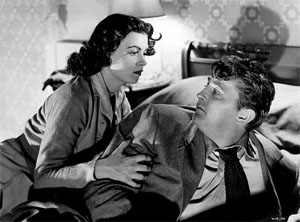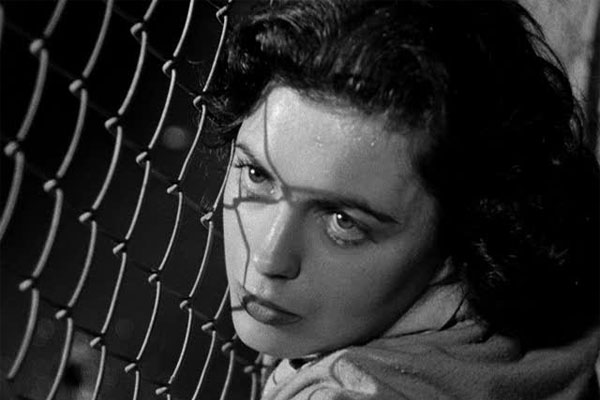Where Danger Lives (1950, Dir. John Farrow):
Noir can be hit-and-miss, but even minor noir films such as Where Danger Lives have their pleasures — and there’s nothing minor about watching icons like Robert Mitchum and Claude Rains in action. Mitchum is your typical kindly doctor, if your idea of a kindly doctor is a guy who calms down a cute child patient with a story about a drowning elephant and gets seduced by a high-society dame (Faith Domergue) with a rich father (Rains) who may not be who he seems. One concussion and one murder later, Mitchum and Domergue are on the run to Mexico — only who’s dragging who along for the ride?
Coming off his career-defining work The Big Clock, director John Farrow applies an almost impish approach to the material, helped along by Charles Burnett’s screenplay. Burnett worked on early Hitchcock movies, and we can see the master’s earmarks on the story — an innocent man on the run, unfortunate combinations of events and timing making life worse for our hero, picaresque adventures with the locals (in this case, a sheriff who can’t wait to write up a car accident report, car salesmen and pawn shop brokers who might be shadier than everyone else, a town crowded with bearded participants for an annual festival). Like The Big Clock, much of the tension comes from the audience’s god-like apprehension of what’s going on: we see how every little twist conspires against the best efforts of Mitchum to extricate himself.
 “Nobody pities me — nobody!”
“Nobody pities me — nobody!”
— Faith Domergue, Where Danger Lives
Mitchum gets to have fun this time around, as he becomes increasingly groggy after getting a blackjack to the head — his decelerating line delivery becomes an ironic comment on his slowball acting style. In his pivotal scene, Rains puts on a clinic, and Nicholas Muscuraca’s black-and-white photography supplies a healthy dose of atmosphere; a seven-minute scene just before the film’s climax at the Mexican border (prefiguring Orson Welles’ Touch of Evil nearly a decade later) is shot with a single fluid take, easily circling around two combatants in a bedroom.
What prevents Where Danger Lives from reaching classic status is the presence of Faith Domergue — wide-eyed and thick-lipped, she certainly passes as a femme fatale in the looks department, but she’s not actress enough to bring out the shades of sexuality, desperation, and mania in her character. (Turns out that Domergue was one of Howard Hughes’ squeezes at the time — the film is produced by Hughes’ RKO.) Since the whole plot hinges on the premise that man-of-the-world Mitchum, even in a dazed state, would let Domergue play him for a complete sucker, her less-than-convincing performance leads to a less-than-convincing film. We haven’t even mentioned Maureen O’Hara, wasted as Mitchum’s steadfast girlfriend in a throwaway part that reduces her to a few soft-focus close-ups. Still, like all noir, there’s no denying that it’s a kick seeing a hapless would-be hero getting squeezed on all fronts, and Farrow’s craftsmanship keeps things humming, if not necessarily transcendent.

